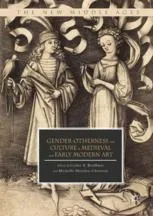Gender, Otherness, and Culture in Medieval and Early Modern Art
4.2
Reviews from our users

You Can Ask your questions from this book's AI after Login
Each download or ask from book AI costs 2 points. To earn more free points, please visit the Points Guide Page and complete some valuable actions.Introduction to "Gender, Otherness, and Culture in Medieval and Early Modern Art"
"Gender, Otherness, and Culture in Medieval and Early Modern Art" explores the complexities and nuances of gender representation and identity in the art of medieval and early modern periods. Edited by Carlee A. Bradbury and Michelle Moseley-Christian, this scholarly collection looks at how art serves as a cultural artifact that not only reflects societal norms but also challenges and redefines them through engaging visual narratives. The book underscores vital connections between artistic expression and broader cultural currents that influenced conceptions of gender and otherness.
Detailed Summary of the Book
In this meticulously curated anthology, the editors collect essays by various scholars that delve into the portrayal of gender and otherness in medieval and early modern art. The book dissects how artists represented marginalized groups, such as women and so-called "others," and the impact these representations had on the cultural narratives of their time. Each chapter is dedicated to examining different media—manuscripts, sculptures, paintings, and more—addressing topics such as power, identity, and societal constructs. Academics and art enthusiasts alike will find insight into how these historical visual representations illuminate contemporary issues of identity and inclusivity.
Key Takeaways
- Art as a lens to examine gender dynamics across historical milestones.
- The role of imagery in shaping societal narratives of identity and otherness.
- Interdisciplinary approaches combining art history, gender studies, and cultural analysis.
- Insight into the diverse and rich tapestry of cultural expression in medieval and early modern society.
Famous Quotes from the Book
"Art is not merely a reflection of societal values but a potent tool for challenging and reshaping them."
"To understand the past, we must look at what has been left out of history as much as what has been included."
Why This Book Matters
Gender, Otherness, and Culture in Medieval and Early Modern Art" is a landmark text that bridges the gap between historical art analysis and modern cultural critique. It provides readers with the tools to critically engage with how past societies viewed gender and difference, pressing readers to reconsider how these themes resonate today. At a time when questions of identity and representation are paramount, this book offers critical insights into the underpinnings of these discussions within a historical context, making it a vital resource for both academic inquiry and public discourse. By drawing connections between past and present, it highlights the continuous impact of art on societal norms, making it an indispensable reference for anyone interested in the evolution of cultural narratives and gender studies.
Free Direct Download
You Can Download this book after Login
Accessing books through legal platforms and public libraries not only supports the rights of authors and publishers but also contributes to the sustainability of reading culture. Before downloading, please take a moment to consider these options.
Find this book on other platforms:
WorldCat helps you find books in libraries worldwide.
See ratings, reviews, and discussions on Goodreads.
Find and buy rare or used books on AbeBooks.
1218
بازدید4.2
امتیاز50
نظر98%
رضایتReviews:
4.2
Based on 0 users review
"کیفیت چاپ عالی بود، خیلی راضیام"
Questions & Answers
Ask questions about this book or help others by answering
No questions yet. Be the first to ask!


